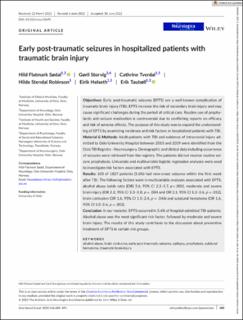| dc.contributor.author | Sødal, Hild Flatmark | |
| dc.contributor.author | Storvig, Gøril | |
| dc.contributor.author | Tverdal, Cathrine Buaas | |
| dc.contributor.author | Robinson, Hilde Stendal | |
| dc.contributor.author | Helseth, Eirik | |
| dc.contributor.author | Taubøll, Erik | |
| dc.date.accessioned | 2022-12-23T09:30:01Z | |
| dc.date.available | 2022-12-23T09:30:01Z | |
| dc.date.created | 2022-09-07T10:54:55Z | |
| dc.date.issued | 2022 | |
| dc.identifier.citation | Acta Neurologica Scandinavica. 2022, 146 (5), 485-491. | en_US |
| dc.identifier.issn | 0001-6314 | |
| dc.identifier.uri | https://hdl.handle.net/11250/3039340 | |
| dc.description.abstract | Objectives
Early post-traumatic seizures (EPTS) are a well-known complication of traumatic brain injury (TBI). EPTS increase the risk of secondary brain injury and may cause significant challenges during the period of critical care. Routine use of prophylactic anti-seizure medication is controversial due to conflicting reports on efficacy and risk of adverse effects. The purpose of this study was to expand the understanding of EPTS by examining incidence and risk factors in hospitalized patients with TBI.
Material & Methods
Adult patients with TBI and evidence of intracranial injury admitted to Oslo University Hospital between 2015 and 2019 were identified from the Oslo TBI Registry - Neurosurgery. Demographic and clinical data including occurrence of seizures were retrieved from the registry. The patients did not receive routine seizure prophylaxis. Univariate and multivariable logistic regression analyses were used to investigate risk factors associated with EPTS.
Results
103 of 1827 patients (5.6%) had new-onset seizures within the first week after TBI. The following factors were in multivariable analyses associated with EPTS; alcohol abuse (odds ratio [OR] 3.6, 95% CI 2.3–5.7, p < .001), moderate and severe brain injury (OR 2.2, 95% CI 1.3–3.8, p = .004 and OR 2.1, 95% CI 1.2–3.6, p = .012), brain contusion (OR 1.6, 95% CI 1.0–2.4, p = .046) and subdural hematoma (OR 1.6, 95% CI 1.0–2.6, p = .052).
Conclusion
In our material, EPTS occurred in 5.6% of hospital-admitted TBI-patients. Alcohol abuse was the most significant risk factor, followed by moderate and severe brain injury. The results of this study contribute to the discussion about preventive treatment of EPTS in certain risk groups. | en_US |
| dc.language.iso | eng | en_US |
| dc.publisher | Wiley | en_US |
| dc.rights | Navngivelse-Ikkekommersiell 4.0 Internasjonal | * |
| dc.rights.uri | http://creativecommons.org/licenses/by-nc/4.0/deed.no | * |
| dc.title | Early post-traumatic seizures in hospitalized patients with traumatic brain injury | en_US |
| dc.title.alternative | Early post-traumatic seizures in hospitalized patients with traumatic brain injury | en_US |
| dc.type | Peer reviewed | en_US |
| dc.type | Journal article | en_US |
| dc.description.version | publishedVersion | en_US |
| dc.source.pagenumber | 485-491 | en_US |
| dc.source.volume | 146 | en_US |
| dc.source.journal | Acta Neurologica Scandinavica | en_US |
| dc.source.issue | 5 | en_US |
| dc.identifier.doi | 10.1111/ane.13670 | |
| dc.identifier.cristin | 2049404 | |
| cristin.ispublished | true | |
| cristin.fulltext | original | |
| cristin.qualitycode | 1 | |

